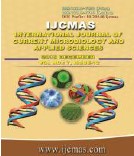


 National Academy of Agricultural Sciences (NAAS)
National Academy of Agricultural Sciences (NAAS)

|
PRINT ISSN : 2319-7692
Online ISSN : 2319-7706 Issues : 12 per year Publisher : Excellent Publishers Email : editorijcmas@gmail.com / submit@ijcmas.com Editor-in-chief: Dr.M.Prakash Index Copernicus ICV 2018: 95.39 NAAS RATING 2020: 5.38 |
The crop phenology, growth and productivity are strongly influenced by changing the cropping season. The kharif (June-Oct.) is the major groundnut- growing season. The CGR is higher in kharif crop than rabi season crop, but the average per day dry matter production is similar in both the seasons. Flowering and fruiting, in groundnut, are of an indeterminate type, which generally has an effect on yield and quality. Ideal type of groundnut would be one that sets all its young fruits within 4-5 days and spends the rest of the growing season filling them. The apparent photosynthesis AP of well- developed canopies may reach values of 6 to 8 gCO2 m-2h-1. The CO2 enrichment from 400 to 800 μ mol mol-1 had positive effects on growth and yield, but not above 800 μmol mol-1. The rate of translocation is positively correlated with net photosynthetic rate and the yield improvement in groundnut, is mainly due to partitioning of assimilates between vegetative and reproductive parts, length of grain-filling period and rate of fruit development. As the light interception is about 95% complete at an LAI of 3, the extinction coefficient for visible radiation was about 1. CGR, RGR and NAR between 60-90 DAS were significantly correlated with pod yield. NAR was negatively correlated with LAI, specific leaf area and the distribution of DM to the pod and was positively correlated with leaf N content Water stress delayed pod initiation, and the major cause of variability in pod yield and harvest index was the delay between peg initiation and onset of rapid pod growth. Under water stress there is poor pod filling that reduced kernel size, shelling percentage, SMK % and lipid content of kernel. Depending upon the stage, moisture stress causes 22-47 % yield reductions.
 |
 |
 |
 |
 |